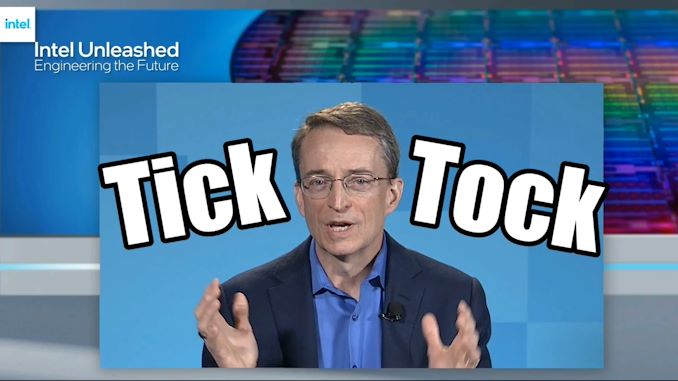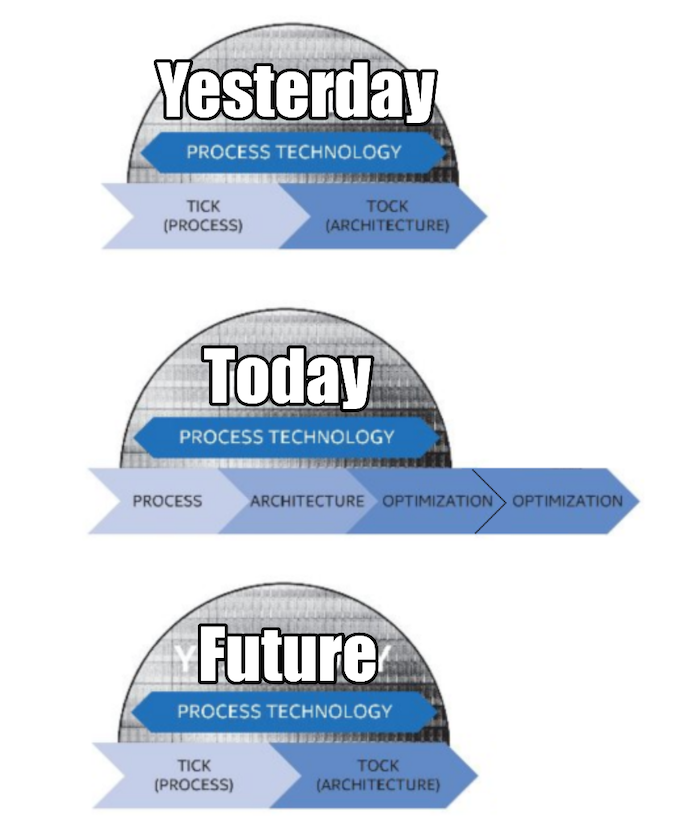Intel to Revive ‘Tick-Tock’ Model, Unquestioned CPU Leadership Performance in 2024/2025
by Dr. Ian Cutress on March 23, 2021 6:31 PM EST- Posted in
- CPUs
- Intel
- Tick-Tock
- 7nm
- Chiplets
- Pat Gelsinger
- Meteor Lake
- Tiles

As part of today’s announcements, during Intel’s Q&A session after the prepared remarks, CEO Pat Gelsinger explained how Intel is going to revive its fortunes when it comes to its leading edge compute products. One of Gelsinger’s mantras seems to be that unquestioned leadership products bring unquestioned leadership margins for those products, and for Intel to execute, it needs to return to its days of old.
In the past, through the 1990s, 2000s, and into the 2010s, Intel’s manufacturing philosophy was known as ‘Tick-Tock’. This means that for every product generation, the leading edge compute hardware was either a Tick (process node enhancement), or a Tock (microarchitecture enhancement). Each generation would alternate between the two, allowing Intel to take advantage of a familiar design on a new process node, or using a mature node to enable a new performance-focused design. That policy was scuppered when delays to Intel’s 10nm forced Intel into more of a Tick-Tock-Optimization-Optimization-Optimization model.
Today CEO Pat Gelsinger stated that at Intel’s core it has to re-establish the Tick-Tock model that enabled repeated leadership in the CPU ecosystem, buoyed by a healthy CPU roadmap. Part of this is re-establishing discipline in Intel’s ranks to continually provide both microarchitecture updates and process node updates on a regular expected cadence. Pat stated as part of the call that Intel will look towards a confirmed yearly process node improvement, and as a result, there might be a lot of Ticks in the future, with a push to more Tocks as well.
On top of this commentary, Pat Gelsinger also stated that Intel’s CPU roadmaps are already baked in through 2021, 2022, and 2023. The company is thus looking to 2024/2025 for ‘unquestioned CPU leadership performance’, which traditionally means the fastest processor for single thread and multi-thread workloads. This is for sure a laudable goal, however Intel will also have to adapt to a changing landscape of chiplet processor designs (coming in 2023), enhancing on-die accelerators (GNA already present), and also what it means to have leadership performance – in the modern era, leadership performance doesn’t mean much if you’re also pushing lots of Watts. Intel stated that its 7nm process is now comfortably on track to deliver Meteor Lake, a client CPU using tiles/chiplets, in 2023, however we are likely looking to a 7nm variant or even external processes for a 2024/2025 product. Intel has also stated that it is looking to consider the core of its leading edge compute on external foundry processes, although one might argue that this doesn’t explicitly say ‘CPU’.
It is also worth noting that Intel/Gelsinger isn’t calling its disaggregated silicon as ‘chiplets’, and prefers to use the term ‘tiles’. This is because Intel’s tiles amount to long wires across 3D packaging technologies like EMIB and Foveros, compared to package-based multi-die interconnect that require buffers as well as control fabric. Tiles by this definition are more costly to implement than chiplets, and have additional thermal considerations by having high-powered silicon close together, so it will be interesting to see how Intel balances these new packaging technologies with the more cost-sensitive elements of its portfolio, such as client processors.
It’s been known that Intel’s microarchitecture teams haven’t been idle waiting for 10nm to come through the pipe, with a number of designs ready and waiting to go for when the process node technology matures. With any luck, if Intel can get a headwind with 7nm, when 2024 rolls around it might all come thick and fast.











109 Comments
View All Comments
atomicWAR - Tuesday, March 23, 2021 - link
I would love to see that happen. But with Intel's track record as of late. I'll believe it when I see it.Operandi - Tuesday, March 23, 2021 - link
Really? Remember Bulldozer? That wasn't that long ago and AMD came back in essentially one architecture and Intel has a lot more resources at their disposal.Personally I just hope 2024/25 is enough time for AMD to gain enough market share and reach more of a market parity with Intel so their aren't perpetually at a disadvantage. Its super hard to compete technologically when your main competitor operates at scale several times what you do.
Gigaplex - Tuesday, March 23, 2021 - link
Bulldozer was a bad architecture and it succeeded in getting process node upgrades. It's not relevant to Intel's track record on not getting new process node upgrades, which is what derailed Tick-Tock.Also, Zen was aided by Jim Keller. Keller left AMD for Intel, where he basically butted heads with their management and left without Intel making good use of him.
drothgery - Tuesday, March 23, 2021 - link
I'd read somewhere that Adler Lake has a lot of Keller's fingerprints on it, so we'll see there. He left AMD before Zen launched, too.silencer12 - Wednesday, March 24, 2021 - link
Keller had a 3 year contract with AMD to develop the "zen" architecture. His contract expired and thus went elsewhere.Santoval - Wednesday, March 24, 2021 - link
Most likely the design of Golden Cove (the "big" cores of Alder Lake) was largely "locked" when Jim Keller joined Intel - at most it required optimizations and "trimming". Back when Keller's hiring was announced Intel also published a LinkedIn ad asking for microprocessor engineers for the design of "Ocean Cove", which was first mentioned by name then.The ad was soon pulled (it appears that the Ocean Cove name was leaked prematurely by mistake) but since it was published just a few days after (or before, cannot quite recall) Intel announced Keller was joining the company the link between the two was unstated but obvious.
Jim Keller is not in the habit of optimizing designs of others; his expertise is in designing / leading the design of *new* designs. When Keller was hired by Intel the design of Ocean Cove was just starting but the design of Golden Cove was largely complete. While I have no proof of this, based on Keller's track record it stands to reason that he would clearly want to work on Ocean Cove, not polish Golden Cove; whether his presumed request was granted by Intel's upper management is unknown though.
dotjaz - Sunday, April 4, 2021 - link
That makes no sense, you don't lock design more than 3 years ahead of release. Golden Cove most likely just started (a couple of months at most) back when Jim joined Intel.It takes roughly 4 years to bring a new design to life. By early 2018 (T minus 3.5 years), Alder Lake would have just come off the initial phase (design specification) and moved to the next phase - behavioral design (including microarchitecture and logic) not long ago.
GeoffreyA - Wednesday, March 24, 2021 - link
"Zen was aided by Jim Keller"Of course, I've got no idea what went on in AMD's design rooms, but I see this recurring idea that Jim Keller's return saved AMD. I'm not trying to put down Mr. Keller, who is highly respected and certainly a genius (lead architect of the K8 and excellent credits elsewhere); but the thing is, isn't it more likely that he was just one of many minds pouring their ideas into Zen? Wasn't Michael Clark the chief architect of Zen? Didn't hundreds of engineers work on it? If he had a big hand in it, we are more than willing to give him due credit, but if not, it is downplaying the work of the other engineers and designers.
whatthe123 - Wednesday, March 24, 2021 - link
Jim Keller led designs on Athlon 64, helped build x86-64 and dominated in performance. Went over to Apple and helped change their whole lineup with the high performing A4. He returned when AMD was at its worst, then Zen ships out and AMD is back on the map.Either he is the luckiest engineer alive, dipping in right as multiple different companies were about to make a breakthrough, or he is a critical part in the success of these architectures. It's obviously a team effort and he is not solely responsible but no one just wanders around the industry and continuously hits home runs.
mukiex - Friday, March 26, 2021 - link
Given lead times for CPUs and how A6/A7 were Apple's first in-house 32-bit and 64-bit cores, I honestly think Keller helped them with the early designs of those chips, rather than the ARM-licensed Cortex cores in A4 and A5. It kinda shows in that Apple's in-house ARM is going toe-to-toe with x86 at this point.